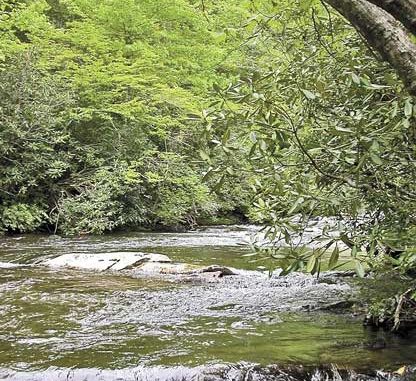
One hard lesson I’ve learned fishing mountain trout streams in the hottest months of summer is this: how you present a fly is far more important than the type of fly you use. If the fly is sufficiently “buggy” and floats naturally, chances are good that a trout will hit it.
Getting a natural float in swift water requires constant line mending, which can be a lot of work. I cast straight ahead whenever possible, quickly mending as the fly floats toward me. At the end of the day, I am physically beat from all the work, but a consistent catch rate makes it all worthwhile.
A friend and I recently fished a backcountry stream noted for its brown trout. He used a No. 14 parachute Adams, and I used a floating inchworm. The temperature was in the mid-80s, hot for the mountains, and we fished from about 8 a.m. to 3 p.m., stopping briefly for lunch.
The strike-rate was consistent from morning to mid-afternoon. Between us, we caught about 30 trout, the majority of them browns, and most of them between eight and 10 inches long.
The stream is in a remote area of Jackson County and is not heavily fished. The water was clear and high, and the stream had a heavy canopy of laurel and rhododendron. We fished with the same patterns most of the day, switching briefly to a hopper pattern once and changing back when it produced no strikes. The day before, we had fished a small, backcountry stream and caught about 25 small rainbows, most of them six to seven inches long. That day we used yellow Stimulators, parachute female Adams and yellow Mayflies.
What we noticed both days was that the trout gave us one chance. If we missed a strike, no amount of fishing or changing flies would produce a second strike. It was one trout per stretch, and one chance per fish.
In both places, presentation was the key factor in getting strikes. If the fly floated naturally, the trout would hit. If the fly showed the slightest drag, it produced nothing.
Most trout fishers quit fishing during July and August, and they’re missing some good fishing. Back-country streams provide consistently good fishing from early spring to late fall. The coldest months are a different story, however. When water temperatures dip in the low 40s, trout just don’t move around as much.
The combination of high elevations and heavy cover during the summer keeps water temperatures at a comfortable level. Rarely will you find a high-country stream with water temperatures above 70.
Following are some tips for trout fishing in late summer.
• Keep a low profile and fish upstream. Trout are spooky, especially when the water is crystal clear and low. Wear colors that blend in with the environment. Tread lightly. Sound is magnified in water, and even if a trout cannot see you, it can hear you coming. Long leaders work best: nothing under nine feet.
• Cast close to banks and under low-hanging laurel and rhododendron bushes. If you can get a float that lasts four or five feet, you likely will get a strike. The minus side is that you’ll get about as many hang-ups as you will get good floats, but the effort is worth it.
When temperatures rise, trout stay in the cooler areas of a stream, where the oxygen content is higher. Areas where small tributaries enter a stream are especially good places for trout to feed.
Summer thunderstorms occur frequently in the mountains. They arrive quickly and leave quickly. At the first sound of thunder, get off the stream and find shelter. A rock-cliff is one of the safer places to be during a severe storm. Most high-country streams have such a high gradient that even a heavy rain will color the water for only a short while. When the water is high, throw in something big, such as a Woolly Booger or Girdle Bug.
Due to the frequent and heavy spring and early-summer rains, trout streams are in the best condition they’ve been in years. And when the weather is hot and muggy, a high-country trout stream offers a pleasant and productive refuge.




Be the first to comment